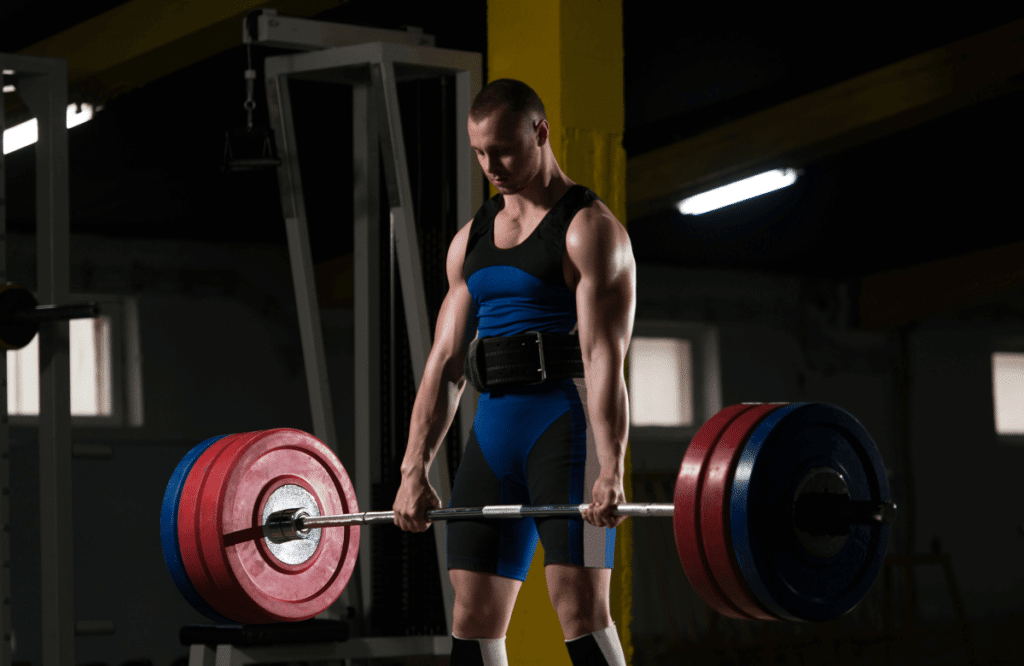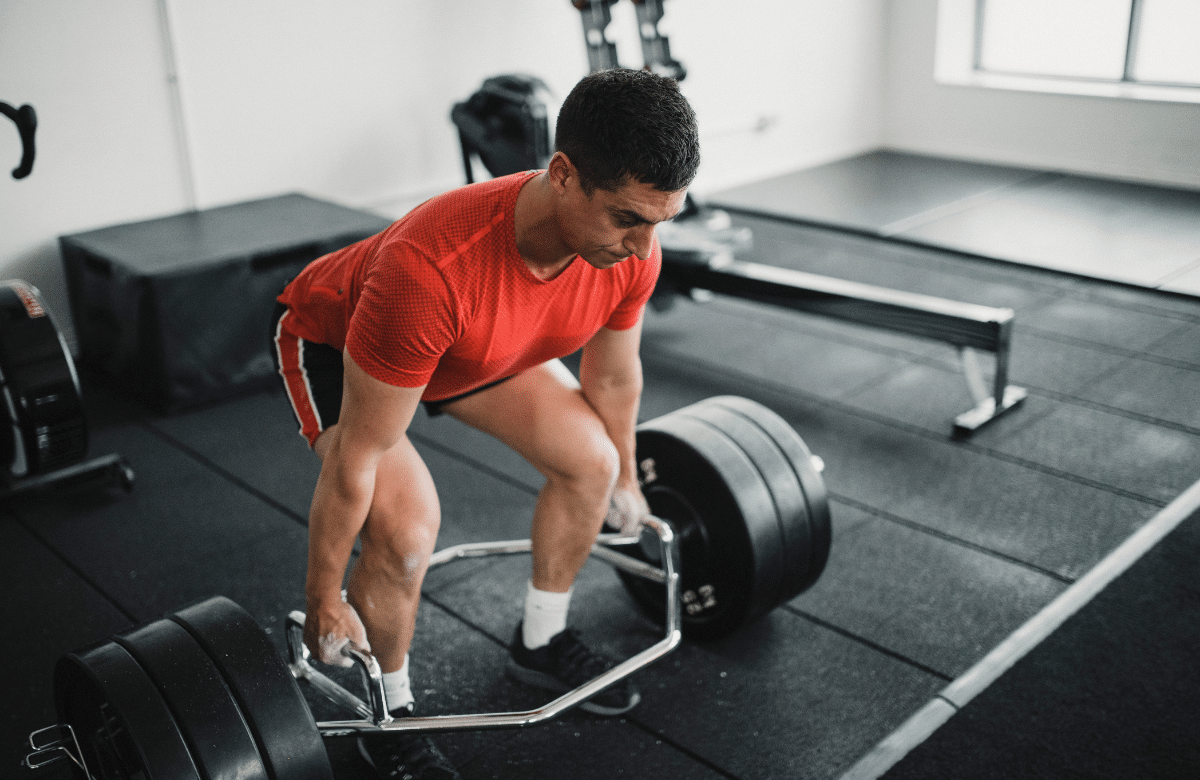The deadlift has been referred to as the ‘king’ of exercises for many years. It has earned this title because it’s one of the larger compound movements, training a lot of muscle in one go. In addition, it’s usually the strongest lift in an athlete’s repertoire, allowing them to lift more weight than any other exercise.
In this article we’re going to explore deadlift for back building, looking at different training approaches to help you get it right.
Jump to:
How deadlifts help your back workout
The conventional deadlift is one of the main compound back exercises people use in their exercise routine. It’s an exercise that trains both the upper body and lower body in a single movement. It builds a lot of strength because you usually lift a heavy weight in the deadlift exercise.
Deadlift for back training is fundamental because although the legs help a lot, a significant amount of the lifting is done with the core muscles and the back muscles. The hip thrust element recruits the muscles of the lower back and the glutes as well.
Different variations of the deadlift target a range of muscles, so you can build a more comprehensive back workout by employing variations of the exercise. We’ll go into more detail on these later on in the article.

Muscles targeted by the deadlift
The deadlift is a hinge movement, which means your back moves from flexion to extension at the hip. It does this by recruiting the muscles of the legs, glutes, hips, core and back.
The initial phase of the deadlift involves a big leg drive – this helps to lift the weight off the floor initially. Once the weight has left the floor, the legs and back work together to keep the bar moving upwards. Once the bar passes the knee, the glutes and trunk muscles work together to pull the bar to the top of the movement.
In relation to the back, the primary muscles targeted by the deadlift are:
- Erector spinae: These muscles run along the spine and help to extend the back.
- Latissimus dorsi: These muscles are located on the sides of the back and help to pull the arms down and back.
- Trapezius: These muscles are located in the upper back and help to raise the shoulders and neck.
- Rhomboid muscles: These muscles are located between the shoulder blades and help to pull the shoulder blades together.
The leg muscles targeted by the deadlift include…
- Quads: These are the muscles at the front of the thigh.
- Gluteus maximus: This muscle is located in the buttocks and helps to extend the hip.
- Hamstrings: These muscles are located in the back of the thigh and help to bend the knee.
- Calves: These muscles are located in the back of the lower leg and help to raise the heel.
There are variations of the deadlift that will train the core muscles more, emphasize the hamstrings more, the quads more etc depending on the set up of the exercise. It means that we can tweak the deadlift exercise in relation to the workout routine and fitness goals.
Using deadlift variation to train the whole back
The word ‘deadlift’ is actually an umbrella term for a range of hinge exercises lifting a weight from a starting position on the floor, to full extension.
When using a deadlift for back training, we can adapt our movements to hit the upper back muscles as well as the mid and lower back. A deadlift workout with back strength as a goal will mix traditional deadlifts with stiff legged deadlifts, trap bar deadlifts, and subsequent exercises for hypertrophy.
We can also factor in using other ways of adding resistance, rather than just conventional barbell deadlifts.

Programming considerations for deadlifts
Like any exercise program, we need to carefully consider the training goal when designing the workout. The deadlift trains the biggest muscle groups in the body – the legs and back. That means it’ll need to be high volume, relatively heavy weight and will need to factor in rest time.
When programming deadlifts, you have to make sure you are providing enough variety (standard deadlifts, trap bar deadlifts, stiff-legged deadlift, deficit deadlifts etc). You also have to factor in fatigue response (to prevent overtraining), and the necessary deadlift assistance exercises.
Further improvements to a deadlift for back program can be made by mixing up the speed and loading of the lifts.
Heavy or lighter loading
Heavy deadlifts are great for building strength. Moderate weight, higher volume deadlifts build muscle. Lighter, faster and explosive deadlifts build power.
If you want to build a great back, I’d suggest you use a mixture of them all.
Heavy deadlifts: Heavy deadlifts are performed with a weight that is challenging but allows you to maintain good form. A good starting point is to use a weight that is 85-95% of your 1-rep max, for 1-3 reps. As you get stronger, you can increase the weight.
Lighter deadlifts: Lighter deadlifts are performed with a weight that is less challenging than your 1-rep max. A good starting point here is to use a weight that is 60-70% of your 1-rep max, for sets of 5-10. As you get stronger, you can increase the weight.
Faster deadlifts: These are designed to increase power and explosive lifting speed. In this case the emphasis is on lighter (50% of 1 rep max) and fast, powerful lifts for 5-8 reps. It’s a way to increase deadlift intensity and improve athleticism.

Deadlift overtraining risk
Deadlifts are a very demanding exercise, and it is possible to overtrain them. If you are experiencing any of the following symptoms, you may be overtraining:
- Fatigue
- Loss of motivation
- Decreased performance
- Increased risk of injury
If you are experiencing any of these symptoms, it is important to take a break from deadlifts and focus on other exercises. It’s not an uncommon phenomenon when deadlift programming, because some people don’t factor in enough versatility. They just keep hitting heavy deadlifts in an attempt to improve their deadlift strength.
A demanding deadlift workout will need time to recover from, so make sure you deadlift programming affords you at least 2 (but ideally 3) rest days each week.
CNS fatigue with heavy deadlifting
Anecdotally, heavy deadlifting has been blamed for causing central nervous system (CNS) fatigue. CNS fatigue is a state of exhaustion that affects the brain and general nervous system, making exercise more difficult. It can cause a number of symptoms, including:
- Impacted exercise technique
- Difficulty executing skills
- Fatigue
- Sleepiness
- Decreased performance
These effects of fatigue are similar to many others, but the main indicator is a disproportionate fatigue from the workouts. A general training fatigue can be recovered from in a day or two. If you are suffering from a version of CNS fatigue, it will likely take longer to recover, so be careful and don’t overdo your training frequency or intensity.
CNS fatigue is generally associated with heavier training sessions over an extended period of time, so it’s important to balance a demanding deadlift workout with easier, lower-intensity deadlift workouts.

Effective deadlift warm ups
In some people, their lower back is vulnerable. This can be due to a lack of lower back strength, previous injury or weaker trunk muscles. Either way, we have to be careful ahead of training the lower back.
Here’s an effective deadlift warm up sequence to help you properly prepare for a deadlift workout…
Low intensity cardio warm up
I like my athletes to warm up with a rowing machine or air bike ideally, because like a deadlift, they recruit almost all of the muscles in the body. The cardio warm up is designed to improve circulation and tissue elasticity ahead of lifting.
It’s not designed to create fatigue, just raise the body temperature and get the body ready for the next exercises.
Lateral band walks
This is a way to warm up the glutes ahead of the deadlifts. It also helps to ‘switch on’ the muscles ahead of lifting. This process aids coordination patterns and muscle firing sequences ahead of the exercises.
Here’s an example of lateral band walks…
Shoot for 3 sets of 20 steps in each direction.
Body weight squats
As a follow on from the lateral band walks, the body weight squats help to turn on the leg muscles and mimic the starting position of the standard deadlift. It’s a light way to get the movement patterns in place before we add load.
Here’s an example of body weight squats…
Shoot for 3 sets of 15 to warm up.
Kettlebell swings
Now the lower body is warmed up, we need to focus on the hinge movement pattern. The kettlebell swing is a fantastic movement for mimicking the hip thrust hinge element of the deadlift. It also helps to drill home the coordination pattern of the hips and glutes during the deadlift.
Here’s the technique…
Shoot for 3 sets of 15 to warm up.
Supplementing deadlifts with core work
Almost all exercise routines require some kind of core work, but it’s particularly important when programming deadlifts. You’ve got a lot of load placed on the lower back, and so the risk of injury increases if it’s not balanced.
Activating the abdominal muscles will help to build core strength and allow you to maintain a neutral spine throughout the lift. This is a huge point – a neutral spine helps to prevent back injuries when lifting.
Creating spinal stiffness to protect the back
My preferred core stability exercises are the ‘McGill Big 3’. These are exercises that are designed to strengthen the abdominal muscles and protect against back pain. They’re commonly used by physical therapists to help back pain patients.
None of these exercises are tough to learn or master and they don’t need any additional equipment.
Here’s the McGill Big 3…
By creating the stiffness through the core, you help your back get into a stronger starting position ahead of the lift, and the neutral position of the spine means you’ll be able to lift smoothly and with better technique.
Sample deadlift program for back training
Here’s a sample deadlift for back training program. We’ll mix conventional style deadlifts with trap-bar deadlifts, deficit deadlifts and other types to train the entire body.
The program will cover different sets, different weights, deadlift intensity and deadlift assistance exercises. We’ll also make sure there’s enough variety and rest in there so you don’t get bored or suffer from disproportionate fatigue from the program.
To maximize the variety and impact of the deadlift for back program, the workout will include heavy, lighter and power deadlifting days.
Workout 1: Strength Day
All exercises here are to be performed with a weight you can cope with on the day. For example, if you’re feeling strong, increase the weight. If you’re feeling less strong, reduce it – just make sure you get the right training effect.
- Standard deadlift: 1 x 10 (warm up), 2 x 6, 1 x 5, 1 x 3
- Trap bar deadlifts (high handles): 3 x 5, 1 x 2
- Dumbbell rows: 4 x 5 per side
- Bench press: 1 x 10 (warm up), 2 x 8, 1 x 6, 1 x 3
- Block pulls: 3 x 3
- McGill Big 3: 3 x 12
Workout 2: Volume Day
- Kettlebell swings: 1 x 25 (warm up), 3 x 15
- Stiff legged deadlifts: 1 x 10 (warm up), 3 x 8
- Trap bar deadlifts (low handles): 4 x 12
- Pull ups: 4 x 8 (weighted if needs be)
- Dips: 4 x 12
- Front squats: 3 x 10
- McGill Big 3: 3 x 12
Workout 3: Power day
All exercises in this workout have to be performed with a working weight of around 50% of the one rep max, but the movement has to be explosive. Warm up weights are light and designed to focus on form and movement quality.
- Kettlebell swings: 1 x 25 (warm up), 3 x 15
- Standard deadlift: 1 x 10 (warm up), 3 x 8
- Sumo deadlift: 1 x 10 (warm up), 5 x 5
- Barbell jump squats: 4 x 8
- Plyometric push ups: 4 x 10
- Push press: 3 x 6
Workout 4: Deadlift accessory day
This workout is designed to cover the exercises that will help you with your deadlift strength and overall athletic performance. They’re a mixture of deadlift assistance exercises and supplemental exercises to support an overall program.
- Kettlebell sumo deadlift high pull: 3 x 10
- Single leg deadlift: 4 x 8 (per side)
- Hip thrusts: 4 x 6
- Hyperextensions: 3 x 10
- McGill Big 3: 3 x 12
This workout will cover every major muscle in the body. It is designed with skeletal muscle hypertrophy in mind, using the deadlift and its variations as our primary compound exercise for training.
Whilst the focus is on the back, it’ll still be effective for anyone on a general strength and performance fitness journey. It trains the entire body, can be scaled to anyone from a moderate level of fitness upwards, and is a training frequency that allows sufficient rest.
This workout covers your entire training week.

Points to consider before designing your own deadlift for back program…
Here’s a few nuggets of wisdom I’ve picked up over my 20 year coaching career in the gym. Bear these in mind when you’re writing your own program…
Don’t do deadlifts to failure…
The injury risk is just too high, and there’s no outstanding benefit worth the risk. Of course go hard, but there’s a big difference between going hard and being stupid. Maintain perfect form throughout your lift – if your form breaks down, the weight is too heavy.
Forget your ego – you don’t want to be the strongest guy in the treatment room. Deadlifts to failure are a sure way to keep your chiropractor rich.
Warm up properly every time…
I know warming up isn’t the most glamorous element of a workout, but it’s one of the most important parts. Yeah, it might be a pain, but you know what’s more painful?
A herniated disc.
Get that warm up done properly. You’ll thank me later.
Give yourself enough rest time…
If deadlifts are your major compound lift, make sure you keep a program to 3-4 workouts per week. You don’t benefit from beating yourself up 5+ times per week. Deadlifts are super demanding on your body. Respect that, and rest accordingly.
My advice is a 2 day on, 1 day off, 2 days on, 2 days off protocol. That could look like this…
- Monday and Tuesday: Train
- Wednesday: Rest
- Thursday and Friday: Train
- Weekend: Rest
This schedule would allow for enough training intensity and adequate rest and recovery. Adjust it to suit your needs, but I’d urge you to not hit 4 or 5 consecutive days.
Don’t neglect core training…
Life is all about balance. Work and rest. Push and pull. You get my point.
The balance you need with a deadlift program involves making sure your supplemental exercise engages your trunk muscles effectively. Having a strong core is a perfect way to ensure your spine is fully supported throughout the whole deadlift.
I recommend the McGill Big 3 – in the sample program you’d do them three times per week. This will give you a strong and stable core, perfect for deadlifting.
Take these points on board and your deadlifting program will be safer and more effective. Get yourself into the gym and get busy – start using the deadlift for back building today!















